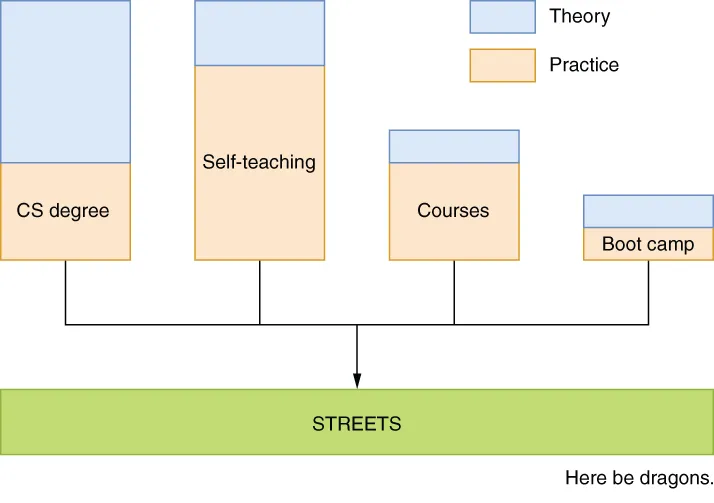
- 272 pages
- English
- ePUB (mobile friendly)
- Available on iOS & Android
About this book
Computer science theory quickly collides with the harsh reality of professional software development. This wickedly smart and devilishly funny beginner's guide shows you how to get the job done by prioritizing tasks, making quick decisions, and knowing which rules to break. In Street Coder you will learn: Data types, algorithms, and data structures for speedy software development
Putting "bad" practices to good use
Learn to love testing
Embrace code breaks and become friends with failure
Beginner-friendly insight on code optimization, asynchronous programming, parallelization, and refactoring Street Coder: Rules to break and how to break them is a programmer's survival guide, full of tips, tricks, and hacks that will make you a more efficient programmer. It takes the best practices you learn in a computer science class and deconstructs them to show when they're beneficial—and when they aren't! This book's rebel mindset challenges status quo thinking and exposes the important skills you need on the job. You'll learn the crucial importance of algorithms and data structures, turn programming chores into programming pleasures, and shatter dogmatic principles keeping you from your full potential. Welcome to the streets! About the technology
Fresh-faced CS grads, bootcampers, and other junior developers lack a vital quality: the "street smarts" of experience. To succeed in software, you need the skills and discipline to put theory into action. You also need to know when to go rogue and break the unbreakable rules. Th is book is your survival guide. About the book
Street Coder teaches you how to handle the realities of day-to-day coding as a software developer. Self-taught guru Sedat Kapanoglu shares down-and-dirty advice that's rooted in his personal hands-on experience, not abstract theory or ivory-tower ideology. You'll learn how to adapt what you've learned from books and classes to the challenges you'll face on the job. As you go, you'll get tips on everything from technical implementations to handling a paranoid manager. What's inside Beginner-friendly insights on code optimization, parallelization, and refactoring
Put "bad" practices to good use
Learn to love testing
Embrace code breaks and become friends with failure About the reader
For new programmers. Examples in C#. About the author
Sedat Kapanoglu is a self-taught programmer with more than 25 years of experience, including a stint at Microsoft. Table of Contents
1 To the streets
2 Practical theory
3 Useful anti-patterns
4 Tasty testing
5 Rewarding refactoring
6 Security by scrutiny
7 Opinionated optimization
8 Palatable scalability
9 Living with bugs
Frequently asked questions
- Essential is ideal for learners and professionals who enjoy exploring a wide range of subjects. Access the Essential Library with 800,000+ trusted titles and best-sellers across business, personal growth, and the humanities. Includes unlimited reading time and Standard Read Aloud voice.
- Complete: Perfect for advanced learners and researchers needing full, unrestricted access. Unlock 1.4M+ books across hundreds of subjects, including academic and specialized titles. The Complete Plan also includes advanced features like Premium Read Aloud and Research Assistant.
Please note we cannot support devices running on iOS 13 and Android 7 or earlier. Learn more about using the app.
Information
1 To the streets
- The realities of the streets
- Who is a street coder?
- The problems of modern software development
- How to solve your problems with street lore
RUN, and voila! The screen was suddenly filled with my name. I was immediately awestruck by the possibilities. If I could do this with 2 lines, imagine what I could do with 6 lines, or even 20 lines! My nine-year-old brain was flooded with so much dopamine that I was addicted to programming at that instant.1.1 What matters in the streets
1.2 Who’s a street coder?

1.3 Great street coders
- Questioning
- Results-driven (aka, “results-oriented” in HR-speak)
- High-throughput
- Embracing complexity and ambiguity
1....
Table of contents
- inside front cover
- Street Coder
- Copyright
- dedication
- contents
- front matter
- 1 To the streets
- 2 Practical theory
- 3 Useful anti-patterns
- 4 Tasty testing
- 5 Rewarding refactoring
- 6 Security by scrutiny
- 7 Opinionated optimization
- 8 Palatable scalability
- 9 Living with bugs
- index
- inside back cover